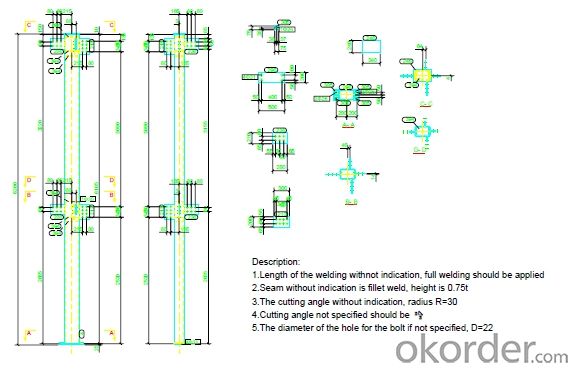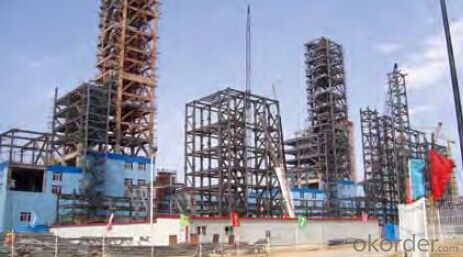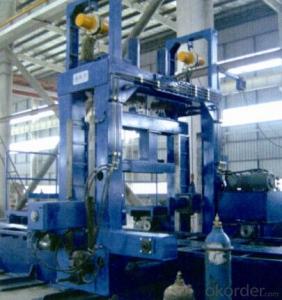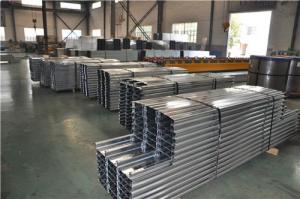Steel Structure made in China
- Loading Port:
- China Main Port
- Payment Terms:
- TT OR LC
- Min Order Qty:
- -
- Supply Capability:
- -
OKorder Service Pledge
OKorder Financial Service
You Might Also Like
Steel Structure
Description:
1.Length of the welding withnot indication,full welding should be applied
2.Seam without indication is fillet weld,height is 0.75t
3.The cutting angle without indication,radius R=30
4.Cutting angle not specified should be 20/20
5.The diameter of the hole for the bolt if not specified, D=22

Project Reference:
Inner Mongolia Shangdu Power Plant is the main source
of west-east power transmission project with total
incestment of 5137 million Yuan. 1,900 tons for the steel
structure of the project with maximum thickness 60mm-
75mm.

- Q:What are the considerations for designing steel communication towers?
- When designing steel communication towers, there are several important considerations to take into account. These include the tower's height and load capacity, the geographical location and environmental conditions it will be exposed to, the type and number of antennas and equipment it will need to support, as well as any applicable regulations and safety standards. Additionally, factors such as aesthetics, maintenance requirements, and cost-effectiveness should also be considered in the design process.
- Q:How are steel stadiums and arenas constructed?
- Steel stadiums and arenas are typically constructed using a combination of steel framework and concrete foundations. The process begins with the excavation and preparation of the site, followed by the construction of the concrete foundation. Next, steel columns and beams are erected to form the skeleton structure of the stadium. Once the steel framework is in place, additional steel components, such as roof trusses and seating sections, are added. Finally, the stadium is enclosed with walls, roofing, and finishing touches such as seating, lighting, and amenities. The use of steel allows for large open spaces, flexibility in design, and durability, making it an ideal material for constructing stadiums and arenas.
- Q:What are the design considerations for steel roof systems?
- When it comes to designing steel roof systems, there are several important factors to consider. These factors include structural integrity, durability, thermal performance, noise reduction, and aesthetics. One of the main things to consider when designing steel roof systems is ensuring that the structure is strong and stable. Steel is a durable material, but it's crucial to ensure that the roof is designed to withstand the various loads it will face, such as wind, snow, and seismic forces. The design should include proper support structures, connections, and bracing to ensure that the roof can handle these loads without failing. Durability is another essential aspect of steel roof system design. Steel is known for its longevity and resistance to weathering, but it's important to incorporate protective coatings or finishes into the design to prevent corrosion and extend the lifespan of the roof system. Regular maintenance and inspections are also necessary to identify and address any potential issues. Thermal performance is also an important consideration. The design should include insulation materials and techniques to minimize heat transfer between the inside and outside of the building. This can improve energy efficiency, reduce heating and cooling costs, and create a comfortable indoor environment. Noise reduction is often a concern with steel roofs because they can amplify sound. To address this, the design should incorporate insulation materials or barriers to minimize noise transmission. This is particularly important in commercial or residential buildings where noise control is crucial for occupants' comfort. Lastly, aesthetics play a significant role in steel roof system design. The design should take into account the desired architectural style and visual appeal of the building. Steel roofs offer a wide range of design options, including different colors, profiles, and finishes, allowing for customization that matches the overall design aesthetic of the building. In conclusion, the design considerations for steel roof systems include structural integrity, durability, thermal performance, noise reduction, and aesthetics. By carefully addressing these considerations, a well-designed steel roof system can provide a long-lasting, energy-efficient, and visually appealing solution for any building.
- Q:How are steel structures designed for resisting chemical exposures?
- Steel structures can be designed to resist chemical exposures by using corrosion-resistant materials, such as stainless steel or galvanized steel, and by applying protective coatings or linings to the surfaces that are exposed to the chemicals. Additionally, careful consideration is given to the selection of materials and design details to minimize the risk of chemical attack and to ensure that the structure can withstand the anticipated chemical exposures.
- Q:How are steel structures designed for foundation settlement control?
- Steel structures can be designed to effectively control foundation settlement through various methods. One common approach is to utilize flexible connections between the steel structure and the foundation. These connections, such as elastomeric bearings or steel sliding plates, allow for small movements and rotations of the structure without transferring excessive loads to the foundation. They are designed to absorb and dissipate the forces generated by settlement, thereby minimizing the impact on the overall stability of the structure. Additionally, steel structures can be designed with adjustable supports or jacks that can be used to compensate for differential settlement. These supports can be adjusted to raise or lower specific areas of the structure, ensuring that it remains level and balanced despite any settlement that may occur. Another technique used in steel structure design for foundation settlement control is the incorporation of structural redundancy. This involves designing the structure with redundant members and connections to provide alternative load paths in case settlement occurs. By distributing the load across multiple structural elements, the effects of settlement can be minimized, and the overall stability of the structure can be maintained. Furthermore, proper geotechnical investigation and analysis are crucial in designing steel structures for foundation settlement control. By understanding the soil conditions and potential settlement patterns at a site, engineers can tailor the design to account for these factors. This may involve implementing additional foundation measures, such as deep foundations or ground improvement techniques, to mitigate settlement risks. Overall, steel structures can be designed for foundation settlement control through the use of flexible connections, adjustable supports, structural redundancy, and appropriate geotechnical analysis. These measures ensure that the structural integrity of the steel construction is maintained, even in the presence of settlement.
- Q:How are steel structures designed for wind pressure loads?
- Steel structures are designed for wind pressure loads by considering factors such as the location and height of the structure, wind speeds, and the shape and orientation of the building. Engineers use various design codes and standards to determine the wind loads acting on the structure. These loads are then analyzed using advanced computer software to assess the structural response and identify potential areas of concern. By incorporating appropriate design parameters and techniques, steel structures can effectively resist wind pressures and ensure the safety and stability of the building.
- Q:How are steel structures used in cultural and historical buildings?
- Steel structures are commonly used in cultural and historical buildings for a variety of reasons. One significant advantage of steel is its strength and durability, making it an ideal material for supporting large and complex structures. This allows architects and engineers to create grand and intricate designs that can withstand the test of time. In cultural and historical buildings, steel structures are often used for their ability to span large distances without the need for excessive columns or supports. This allows for open and spacious interiors, providing visitors with a sense of awe and grandeur. Steel beams and trusses can be used to create large open spaces, such as atriums, exhibition halls, or concert halls, without obstructing views or interfering with the overall design. Moreover, steel structures can be easily modified or expanded, making them suitable for adaptive reuse projects. Many cultural and historical buildings undergo renovations and additions over time, and steel allows for flexibility in design and construction. Steel can be easily integrated into existing structures, preserving the historical integrity of the building while enhancing its functionality and capacity. Additionally, steel structures offer a high level of fire resistance, which is of utmost importance in cultural and historical buildings. Steel does not burn or contribute to the spread of fire, providing an added layer of safety and protection for valuable artifacts, historical documents, and the building itself. Furthermore, steel structures are often used in the restoration of historical buildings. In cases where the original structure has deteriorated or suffered damage, steel can be used to reinforce and stabilize the building, ensuring its preservation for future generations. Steel frames can be hidden within the existing structure, maintaining the historical appearance while providing the necessary structural support. In conclusion, steel structures play a crucial role in cultural and historical buildings by providing strength, durability, flexibility, fire resistance, and the ability to create grand and open spaces. Whether in new constructions, adaptive reuse projects, or restoration efforts, steel has proven to be an invaluable material in preserving and enhancing these important landmarks for future generations to appreciate and enjoy.
- Q:What are the requirements for fire protection in steel structures?
- The requirements for fire protection in steel structures typically include the use of fire-resistant materials such as fire-rated coatings, sprays, or intumescent paints applied to the exposed steel surfaces. These materials help to limit the temperature rise of the steel during a fire, preventing structural failure. Additionally, fire protection measures may also involve the installation of fire-resistant barriers, such as fire-resistant walls or ceilings, to compartmentalize the building and prevent the spread of fire. The specific requirements for fire protection in steel structures may vary depending on local building codes and regulations.
- Q:What are the common design considerations for steel structures in airports?
- Some common design considerations for steel structures in airports include factors such as high wind loads, seismic activity, corrosion resistance, fire protection measures, and the ability to support heavy loads from aircraft and equipment. Additionally, considerations for ease of construction, maintenance, and future expansion are also important.
- Q:How does steel perform in terms of sound insulation?
- Steel is not an effective material for sound insulation as it tends to transmit sound vibrations rather than absorb or dampen them.
1. Manufacturer Overview |
|
|---|---|
| Location | |
| Year Established | |
| Annual Output Value | |
| Main Markets | |
| Company Certifications | |
2. Manufacturer Certificates |
|
|---|---|
| a) Certification Name | |
| Range | |
| Reference | |
| Validity Period | |
3. Manufacturer Capability |
|
|---|---|
| a)Trade Capacity | |
| Nearest Port | |
| Export Percentage | |
| No.of Employees in Trade Department | |
| Language Spoken: | |
| b)Factory Information | |
| Factory Size: | |
| No. of Production Lines | |
| Contract Manufacturing | |
| Product Price Range | |
Send your message to us
Steel Structure made in China
- Loading Port:
- China Main Port
- Payment Terms:
- TT OR LC
- Min Order Qty:
- -
- Supply Capability:
- -
OKorder Service Pledge
OKorder Financial Service
Similar products
New products
Hot products
Related keywords


























